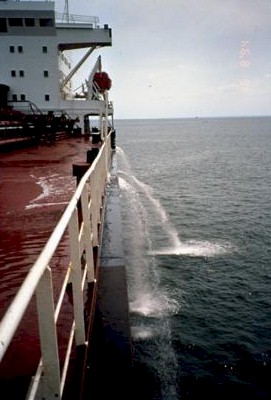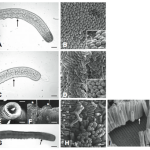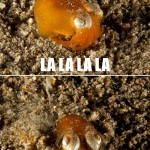California has been a big transition for me. I mean big. Not only am I now living in the sun-drenched utopia I have long pined for (a climate which finally meets my minimum temperature preference of 90F), but I also have leaped into to an entirely new scientific world.
I think I’m becoming a microbiologist.
I say this with a combination of excitement and disdain. On the one hand, I’m frantically clinging to my eukaryotic background and firmly proclaiming myself as, first and foremost, a deep-sea nematode biologist. On the other hand, microbes are just so damn interesting. I’m captivated by their genomic plasticity and capacity for extreme ecology.
One of the big projects in the Eisen lab is microBEnet: a Sloan-funded initiative to foster a research network centered around the Microbiology of the Built Environment. Primarily this has driven interactions between people who wouldn’t normally talk: linking building scientists with microbial ecologists, engineers with biologists. Most of the microBEnet blog posts and discussion has so far focused on the terrestrial built environment: the beasties that live in skyscrapers and office buildings, homes and hotels. But given my propensity to eschew continental realms, I started thinking: What do we know about the microbiology of the built marine environment? By which I mean ships. Oceangoing vessels large and small, traversing treacherous watery passages for months on end, docking in both exotic and familiar places.
Based on my literature survey, what we know about the Microbiology of the Built Marine Environment currently boils down to two areas:
- Transport of microbes that don’t necessarily come in contact with humans, but have severe ecological implications: e.g. invasive species that get transported via ballast water
- People who get sick aboard cruise ships.
Our knowledge of ballast water is both extensive and depressing. Shipping activities have brought invasive species such as zebra mussels into North American waters, and comb jellyfish into the Black Sea.
The stakes are high for ecosystems and shippers. Big cargo ships dock in U.S. waters an estimated 90,000 times each year and unload nearly 200 million tons of ballast. Even relatively isolated ports, such as those in the Great Lakes, “are connected to almost every other port on the planet through four or five ship voyages,” says David Lodge, an ecologist at the University of Notre Dame in South Bend, Indiana. Those linkages have enabled some organisms to travel far from home: Roughly one-half of the 59 invasive species known to have colonized the Great Lakes since the late 1950s, for instance, likely arrived in ballast tanks, according to a 2007 report to the U.S. National Academy of Sciences’s Transportation Research Board. Those invaders include the now-pervasive zebra mussel (Dreissena polymorpha), which has clogged industrial pipes and displaced native animals. Overall, such invasions cost about $130 million annually in the Great Lakes alone, Lodge and colleagues estimated in a February 2011 study in the journal Ecosystems. And saltwater habitats haven’t fared much better. Researchers suspect that ballast tanks carried troublesome Asian shore crabs (Hemigrapsus sanguineus) to the Northeast coast of the United States, and Asian clams (Potamocorbula amurensis) to San Francisco Bay—although it’s possible that some invaders simply hitched a ride on the outer hulls of ships [via Science]

Unfortunately, most observations of invasive species relate to things we can see with the naked eye. Little is known about microbial invaders…FROM BALLAAAAAAAAAAST:
For more than 20 years, scientists have reported a variety of large, easily recognized phytoplankton (e.g.dinoflagellates and diatoms) and protozoa (e.g. ciliates and foraminifera) in ballast water. On the other hand, the diversity of smaller, less readily discerned forms, especially bacteria and viruses, is nearly unknown. We do know something, however, about their abundance. In lakes and oceans, every millilitre of surface water contains about 102 protists, 106 bacteria, and between 107 and 109 viruses. It is inevitable, therefore, that hundreds of trillions of micro-organisms enter a single ship’s ballast tanks during normal operations.
Although the overwhelming majority of these aquatic micro-organisms is not harmful to humans, some species in ballast water do indeed represent potential risks to public health, notably pathogenic bacteria such as Vibrio cholerae, the aetiologic agent of human cholera, and dinoflagellates, some species of which are responsible for harmful ‘red tides’. Other pathogens and faecal-indicator micro-organisms reported from ballast tanks include: enteroviruses, Escherichia coli, enterococci, Cryptosporidium parvum and Giardia duodenalis. Reported harmful algae species include: Pfiesteria piscicida, P. shumwayae, Aureococcus anophagefferens, Microcystis spp. and Anabaena spp. While to the best of our knowledge, no outbreaks of disease have been associated with ships’ ballasting activities, it is only on very, very rare occasions that ballast tanks are sampled for their microbiological inventories. [Microbiology today]
The question for microbes is: “is Everything Everywhere?” As in, are microbes floating in the ocean restricted to specific geographic ranges (even though its pretty hard to imagine habitat boundaries in a giant pool of water)? Or are these species really globally distributed? If the former is true, we might be pretty screwed; invasive microbes could be mooching off ballast water, using it as their own luxury cruise liner to conquer new habitats. Of course, there are shipping practices in place such as Mid-Ocean Exchange (MOE) of ballast water, which is meant to flush out and purify ships’ tanks. It doesn’t look like this practice is effective for reducing the number of bacteria that are transported in ballast (Seiden et al 2010), but in theory it might expunge pathogenic or aggressively invasive species that a ship may have been carrying from its last port call. Other potential ways of wiping out microbes could be accomplished through treatment methods such as electrochemical disinfection, UV sterilization, ultrasound treatment and high voltage pulses of electricity. But even these cool-sounding methods might be useless, since bacteria can apparently hang out in zooplankton carcasses and globs of marine gunk, sheltering themselves until the treatment is over. Then, just as the humans are sitting back and relaxing, the microbes reappear: “S’up guys, we’re just going to repopulate this ballast water and look past the fact you tried to do us in. Nah man, no hard feelings, but we’ve got some beef with your native species”. There’s no killing those microbes, they’re just too badass. They’re like the honey badger of the ocean.
The second category relating to the Microbiology of the Built Marine Environment can be summarized in a single phrase: projectile vomit. Firstly, because microbes on cruise ships often cause passengers to become very, very ill. Secondly, because after you finish this post, you’d better have a trash can or bathroom nearby.
Microbes on ships prompt a whole lot of vomit. And diarrhea. Neither of which I can imagine is very fun to experience on the high sea, with wind and waves and the motion sickness that affects even healthy passengers. You can get sick aboard a cruise ship from bacteria such as Enterotoxigenic Escherichia coli, which might be lurking in the ice cubes floating in your Singapore Sling. Or someone comes onboard with a slight illness that turns out to be a Noroviruses. These can cause pretty nasty stomach flu in humans (unless you are genetically resistant, which I unfortunately am not), and outbreaks are fairly common aboard cruise ships. Hell, you might not even have to come in contact with an ill passenger–on cruise ships, noroviruses can be transmitted via drinking water, pools, and contaminated food.
The most disturbing potential source of cruise ship illnesses? Cockroaches. Apparently they can carry everything from bacteria and viruses to protists, fungi, and parasitic worms on their body. Cockroach infestations tend to affect (surprise) areas where there is FOOD – the galley and mess hall. And given that previous studies have found seafaring cockroaches to be carriers of pathogens such as Enterbacteriaceae and Salmonella, these creepy crawlies could pose serious threats to human health.
In 2005, Oldenburg and Baur conducted a pilot study on cockroach infestations on German ships in the port of Hamburg:
In total, inspectors found cockroach infestation in 6 of 59 ships (10.2%). The average age of these 6 vessels was approximately twice that of the non infested ones (19.0 vs 9.0 years)…Cockroach infestation was detected on 4 container ships, 1 cargo ship, and 1 bulk carrier. Of the infested vessels, 4 (66.7%) regularly stayed in the tropics…Because ships frequently stay in different climatic zones ann because some areas of a ship (e.g. the galley) have a perennially warm and humid climate, shipboard conditions may differ from the outside climate and thus encourage infestation year round
Which means all those tropical cruise ships might be especially prone to harboring beady-eyed arthropod stowaways. And the crew might not even know it.
Cockroach infection was detected on 3 ships without having been recognized by the crew. This indicates that seafarers are not aware of the true extent of shipboard cockroach infestation.

And there have been plenty of news stories suggesting pest problems aboard well-known passenger liners. Four different English cruise liners (run by P&O, Thompson, Fred Olsen cruises and Cunard) were nailed by health inspectors in Southampton, UK after finding cockroaches and flies onboard. Cockroaches were detected on the Ocean Glory 1 after a weeklong cruise in Norweigan Fjords. Even the prestigious Queen Mary 2 was slammed by health inspectors in New York who found cockroaches and fruit flies. The list goes on but I’ll stop there. And for your own sanity, I implore you–DO NOT google “cockroaches cruise ships” or you will NOT sleep tonight. I have taken the bullet for this one on behalf of all you dear readers, and I assure you I will be compulsively showering 10 times a day for at least the next week.
I wrote this post to get people thinking, but I might have just creeped everyone out. (I’ve definitely creeped myself out–I really hate cockroaches). Most of the information about the Microbiology of the Built Marine Environment is anecdotal, with a few preliminary scientific studies peppered here and there. But this would be SUCH a cool topic to research, and I can’t stop listing out questions that I would love to answer, such as:
How does being at sea, aboard a closed vessel, affect the human microbiome? Scientists and Crew often arrive from far-flung locations and subsequently proceed to live in close quarters for extended periods of time, sometimes months on end. Do their microbiomes converge or somehow affect each other? Do peoples’ microbiome populations change because of the isolated nature of a voyage at sea (especially for long-term crew on container vessels, cruise liners, or research ships)? There would be no unlimited source populations to replenish useful microbes from the groceries, soil, or air. Does this affect competition and change the human microbial community? I’d love to sample scientists’ body sites for microbes as they first board a ship, and then sample again months down the line when they finally disembark, to see if (how) their microbiome communities might have changed.
What types of microbial assemblages inhabit ships? Are communities similar across all ships (perhaps representing a convergent, globally ubiquitous shipboard community that can tolerate salty conditions?), or does ship microbiology depend on the nationality of the ship. Is there a typical “British vessel” community fingerprint, and if so, how might it differ from “Malaysian vessel” microbial assemblages? And how do these assemblages vary across space and time? Can we identify a specific “galley” microbial community, versus as “engine room” microbial community?
So when you think about it, the microbiology of ships must be crazy! Oceangoing vessels are essentially man-made islands for microbes–engineered terrestrial habitats, perhaps re-colonized by the local fauna at port calls and populated with far-flung taxa brought aboard by a diverse array of international travelers. Pests such as cockroaches act as vectors–they squeeze into shipboard nooks and crannies, smearing microbes around as they scurry. We don’t know much right now, but I hope this post might inspire some bored seafaring scientists to undertake a sampling mission. (Just don’t go looking for cockroaches.)






My Google Alert informed me of your blog–good stuff! Especially liked the quote about ballast-water bugs from Microbiology Today!
If you want to head back to the East Coast, but stay warm, consider applying for this job in my lab in Virginia(see below)
Sincerely,
Fred Dobbs
POST-DOCTORAL RESEARCH ASSOCIATE (#12019)
Old Dominion University’s Department of Ocean, Earth, and Atmospheric Sciences seeks a post-doctoral candidate to design, carry out, and analyze microbiology experiments intended to test ecological theory (see Lyons et al. 2010. Aquat. Micro. Ecol. 60:1-13.) The successful candidate will have training in microbial ecology and ecological theory; experience in experimental design and analysis, qPCR analyses, and analysis of next-generation sequencing data; strong writing skills as demonstrated by publication of peer-reviewed scientific papers; and proven ability to work independently. Travel and presentation of results at scientific meetings is required. Experience with sole-carbon source utilization analyses and confocal microscopy is a plus. Send a CV, cover letter, and names of three references to Old Dominion University Research Foundation, P.O. Box 6369, Norfolk, VA 23508 or e-mail to [email protected]. Specify job # 12019. Position will be open until filled. AA/EOE More about Old Dominion University’s Department of Ocean, Earth, and Atmospheric Sciences can be found at http://www.odu.edu/sci/oceanography/.